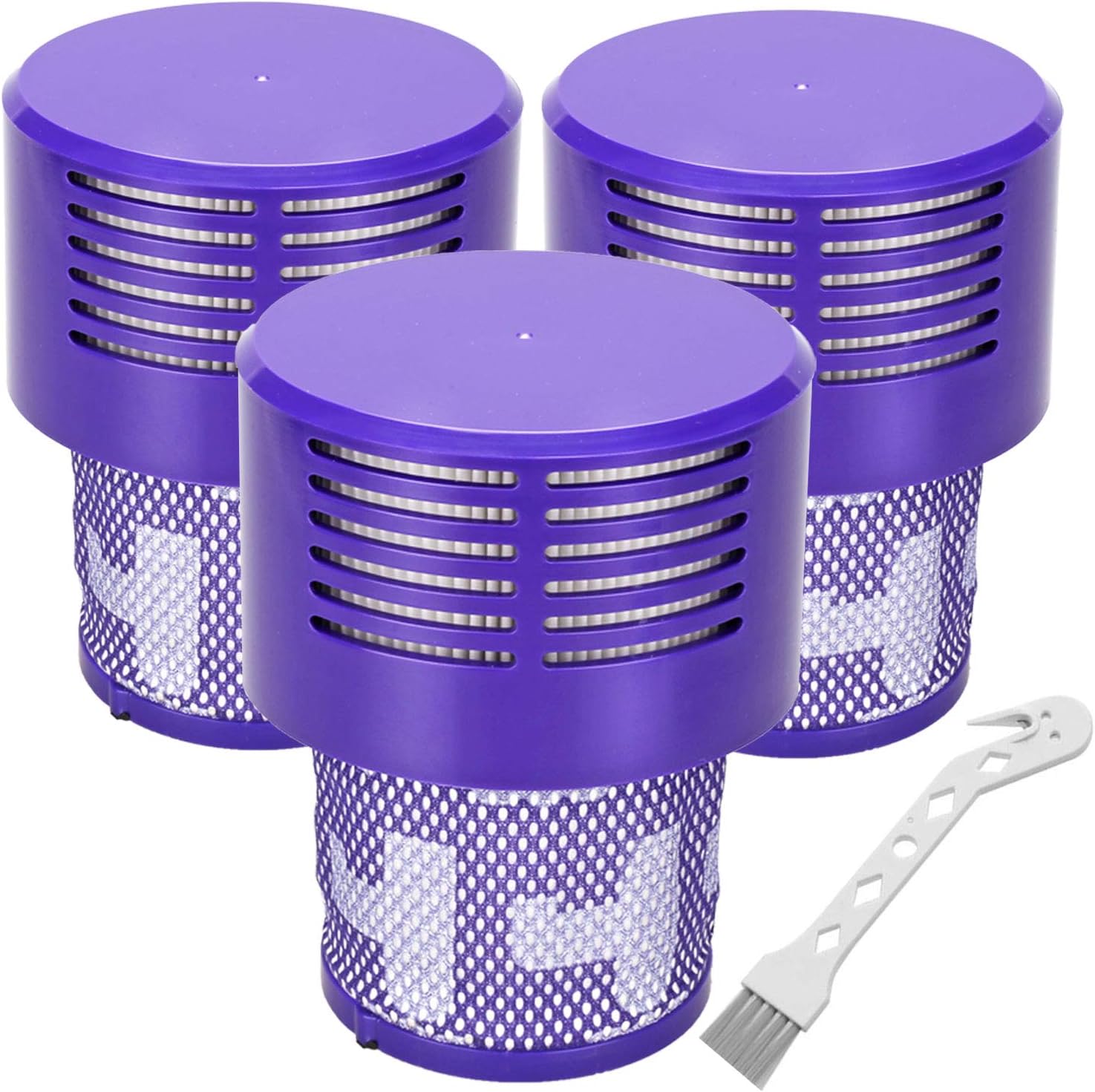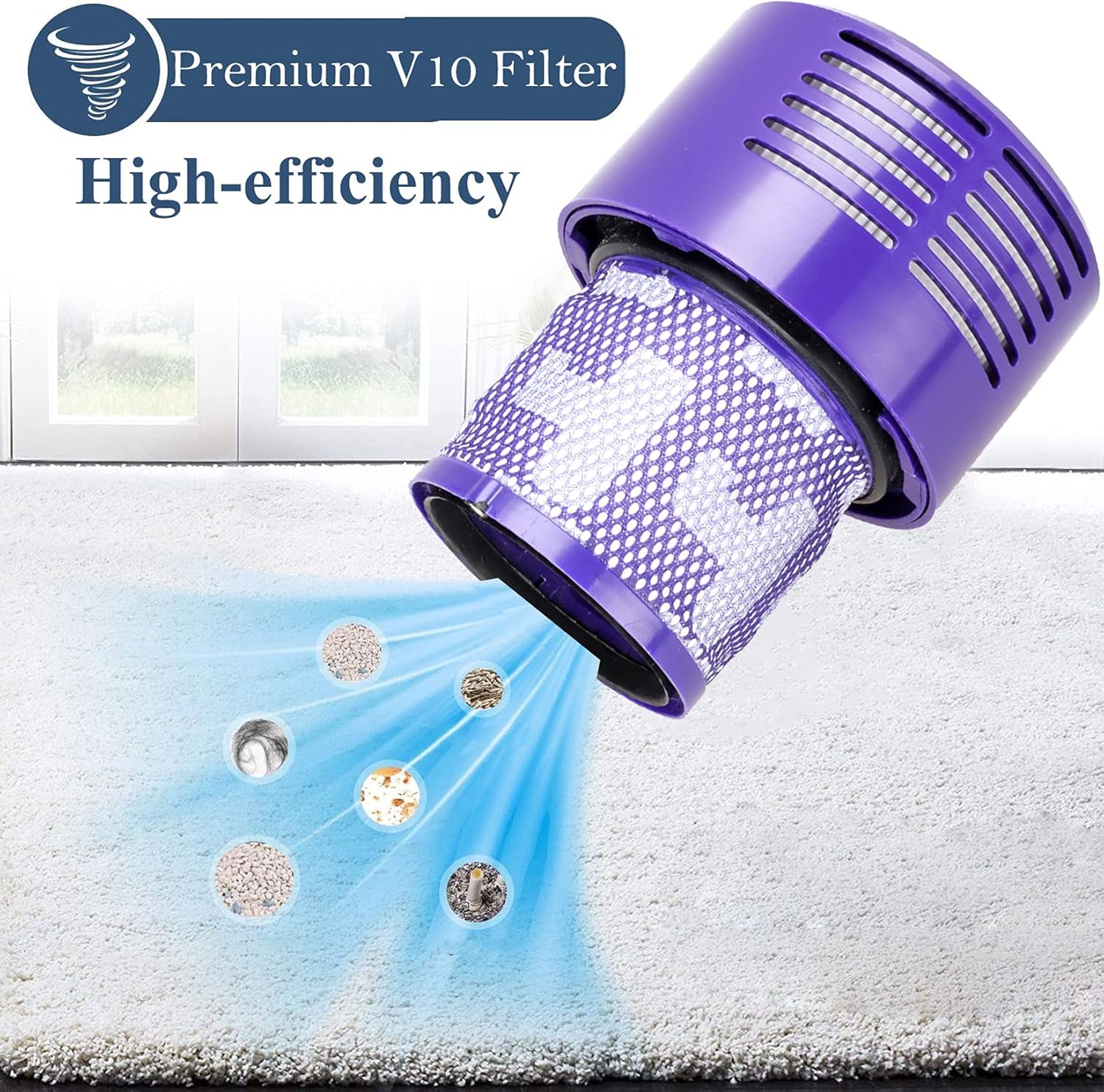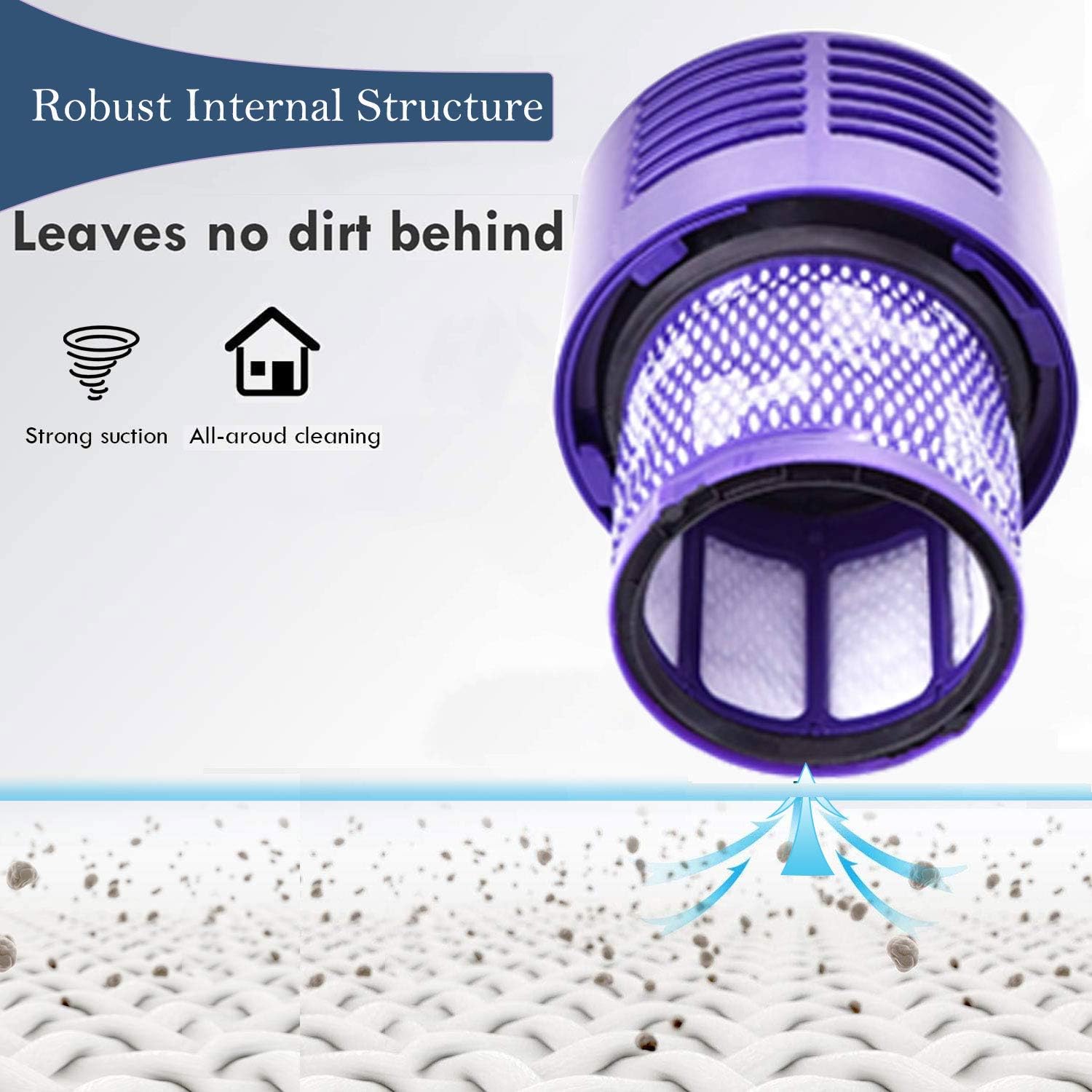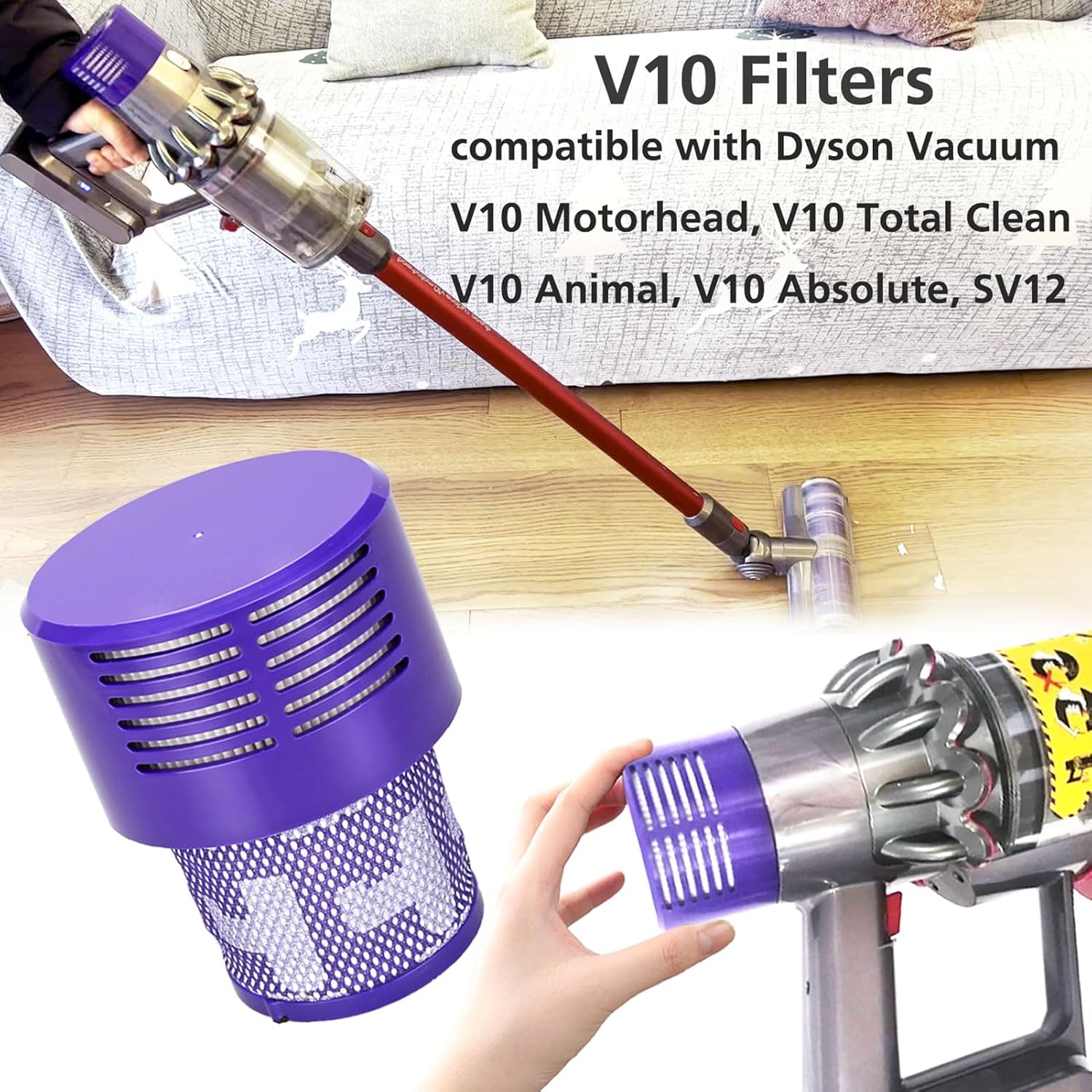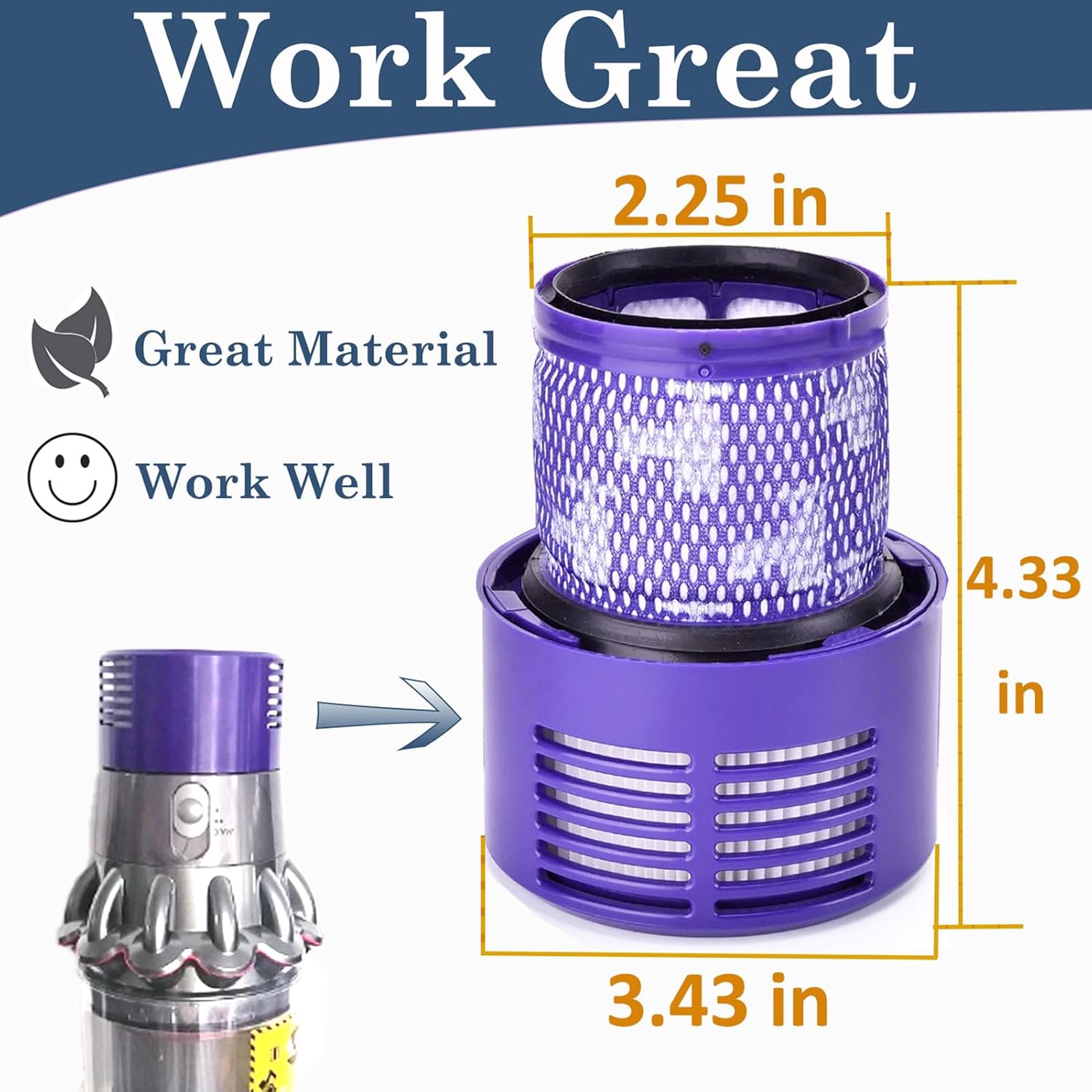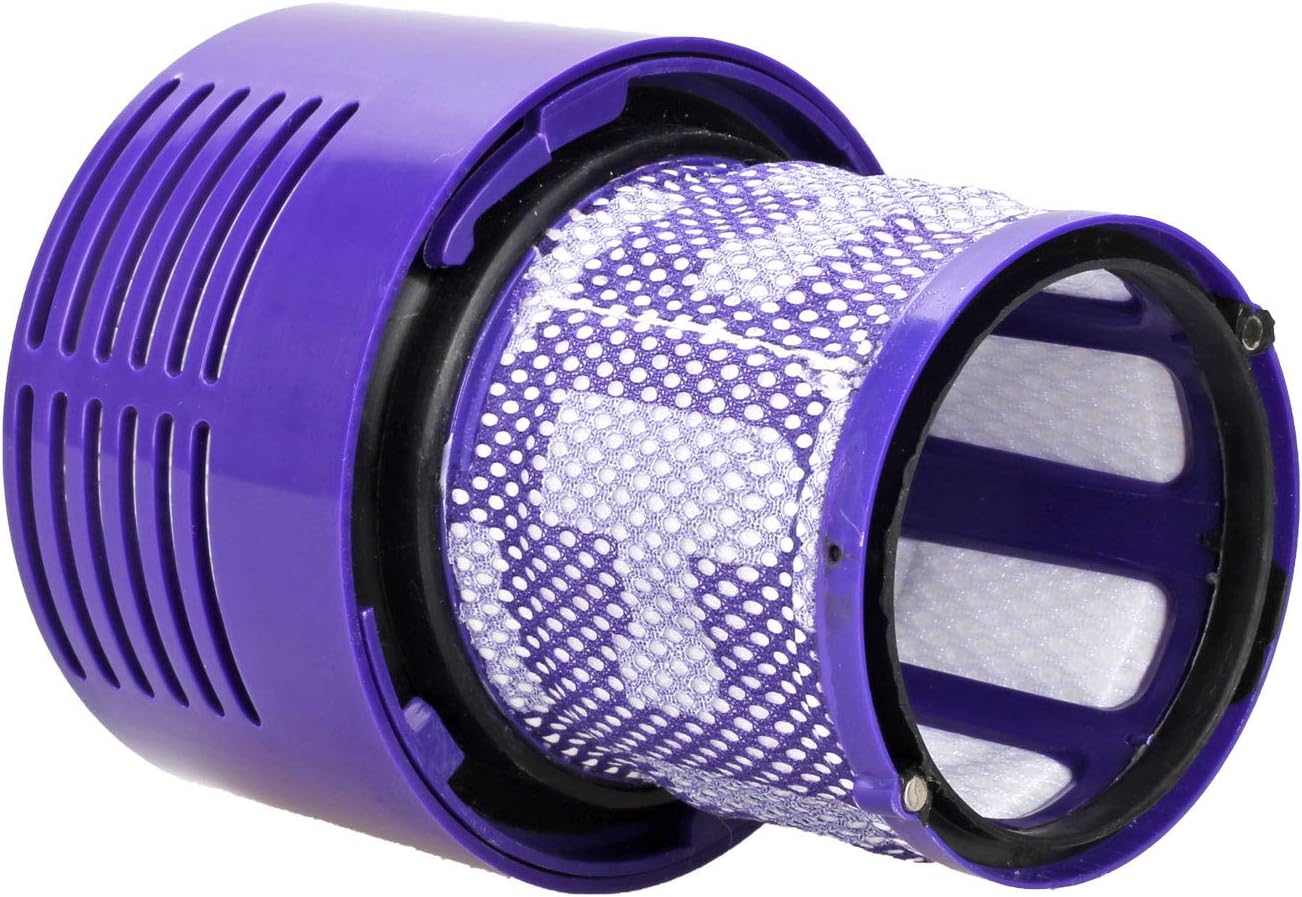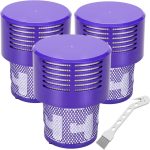
Replacement V10 Filters for Dyson V10 Review dyson v10 – Oemiu
Replacement V10 Filters: Maintaining Peak Performance for Your Dyson V10
The Dyson V10 Cordless Vacuum Cleaner is a marvel of modern engineering, a powerhouse of suction wrapped in a sleek, lightweight design. Its impressive performance, however, relies heavily on a crucial component: the filter. Over time, this filter becomes clogged with dust, debris, and allergens, hindering the V10’s ability to effectively clean your home. That’s where replacement V10 filters come in. Choosing the right replacement filter is essential to maintaining the suction power, air quality, and overall lifespan of your Dyson V10. Let’s dive into the world of V10 filters and explore how to keep your vacuum running like new.
Understanding the Vital Role of the Dyson V10 Filter
The filter in your Dyson V10 isn’t just a passive component; it’s an active participant in the cleaning process. Its primary function is to trap fine dust particles, allergens, and other microscopic debris that would otherwise be expelled back into your home. This is particularly important for allergy sufferers and those with respiratory sensitivities. A clean, functioning filter ensures that the air expelled by your Dyson V10 is cleaner than the air you’re vacuuming, a feature that sets Dyson apart from many other vacuum brands.
Beyond air quality, the filter plays a critical role in maintaining the vacuum’s suction power. A clogged filter restricts airflow, forcing the motor to work harder to achieve the same level of suction. This increased strain not only reduces the vacuum’s efficiency but can also lead to overheating and premature motor failure. Regularly replacing your V10 filter prevents this strain, ensuring that your vacuum operates at peak performance for years to come. Think of it like changing the oil in your car – it’s a small investment that protects a much larger and more expensive piece of equipment.
The original filter included with your Dyson V10 is designed to be washable, but even with regular cleaning, it will eventually degrade and lose its effectiveness. Over time, the filter media can become damaged, allowing fine particles to pass through. Additionally, repeated washing can cause the filter to lose its shape and fit improperly, further compromising its performance. This is why replacement filters are a necessary part of owning a Dyson V10. Choosing a high-quality replacement ensures that you continue to enjoy the same level of performance and air quality that you experienced when your vacuum was new. Investing in quality replacement filters for your Dyson V10 vacuum is an investment in the air quality of your home.
Choosing the Right Replacement Filter: OEM vs. Aftermarket
When it comes to replacing your Dyson V10 filter, you have two primary options: Original Equipment Manufacturer (OEM) filters and aftermarket filters. OEM filters are manufactured by Dyson themselves and are designed specifically for your V10 model. Aftermarket filters, on the other hand, are produced by third-party manufacturers and are often marketed as a more affordable alternative. Both options have their pros and cons, and the best choice for you will depend on your individual needs and priorities.
OEM filters are guaranteed to fit perfectly and meet Dyson’s stringent quality standards. They are typically made from high-quality materials and are designed to provide optimal filtration and airflow. However, OEM filters are also generally more expensive than aftermarket options. If you prioritize performance, longevity, and peace of mind, an OEM filter is likely the best choice.
Aftermarket filters can offer significant cost savings, but it’s crucial to do your research before purchasing one. Not all aftermarket filters are created equal, and some may be of inferior quality. A poorly made filter can restrict airflow, reduce suction power, and even damage your vacuum. Look for aftermarket filters that are made from HEPA-grade materials and have been tested for filtration efficiency. Read reviews carefully and choose a reputable brand with a proven track record.
Here’s a table comparing OEM and Aftermarket filters:
| Feature | OEM Filter | Aftermarket Filter |
|---|---|---|
| Manufacturer | Dyson | Third-party |
| Price | Higher | Lower |
| Fit | Guaranteed | Variable |
| Quality | Typically higher | Variable |
| Filtration | Optimal | Variable |
| Warranty | Dyson Warranty | Varies by manufacturer |
Ultimately, the decision of whether to choose an OEM or aftermarket filter depends on your budget and your tolerance for risk. If you’re willing to spend a little more to ensure the best possible performance and longevity, an OEM filter is the way to go. However, if you’re on a tight budget, a carefully selected aftermarket filter can be a viable alternative. Just be sure to do your homework and choose wisely. And remember, protecting your investment in your Dyson V10 is worth a little extra effort.
Key Features to Look for in a Dyson V10 Replacement Filter
When selecting a replacement V10 filter, several key features can significantly impact its performance and lifespan. Understanding these features will help you make an informed decision and choose a filter that meets your specific needs.
* **HEPA Filtration:** This is perhaps the most important feature to look for. HEPA (High-Efficiency Particulate Air) filters are designed to capture at least 99.97% of particles 0.3 microns in diameter. This includes dust mites, pollen, pet dander, and other common allergens. A HEPA filter will significantly improve the air quality in your home.
* **Washability:** While all V10 filters are washable, some are more durable and can withstand more frequent washing than others. Look for filters that are made from high-quality materials and are designed to retain their shape and filtration efficiency after repeated washing.
* **Filter Material:** The type of material used in the filter construction also matters. Some filters use a combination of materials, such as activated carbon, to further enhance their filtration capabilities. Activated carbon filters can help remove odors and volatile organic compounds (VOCs) from the air.
* **Fit and Compatibility:** Ensure that the filter you choose is specifically designed for your Dyson V10 model. A poorly fitting filter can leak dust and debris, reducing its effectiveness and potentially damaging your vacuum.
* **Durability:** A durable filter will last longer and require less frequent replacement. Look for filters that are made from robust materials and are designed to withstand the rigors of regular use. Consider the reviews that mention the life of the filter to ascertain its longevity.
Beyond these core features, consider the overall construction and design of the filter. A well-designed filter will have a tight seal and will be easy to install and remove. It should also be easy to clean and maintain. Remember, the filter is the workhorse of your Dyson V10, so choosing a high-quality replacement is essential for maintaining its performance and longevity.
Maintaining Your Dyson V10 Filter for Optimal Performance
Regular maintenance is crucial for maximizing the lifespan and performance of your Dyson V10 filter. Even the best replacement filter will become clogged over time if it’s not properly cared for. Fortunately, cleaning and maintaining your V10 filter is a simple process that can be done in just a few minutes.
The recommended cleaning frequency is typically once a month, but this may vary depending on your usage habits and the environment you’re cleaning. If you frequently vacuum pet hair or fine dust, you may need to clean the filter more often. A good rule of thumb is to check the filter regularly and clean it whenever it appears dirty or clogged.
To clean your Dyson V10 filter, follow these steps:
1. Remove the filter from the vacuum. Refer to your Dyson V10 user manual for specific instructions on how to remove the filter.
2. Tap the filter gently against a hard surface to remove any loose dust and debris.
3. Rinse the filter under cold running water. Be sure to rinse both the inside and outside of the filter.
4. Gently squeeze the filter to remove excess water. Do not twist or wring the filter, as this can damage the filter media.
5. Allow the filter to air dry completely. This may take up to 24 hours. Do not use a hair dryer or other heat source to dry the filter, as this can damage the filter material.
6. Once the filter is completely dry, reinstall it in your vacuum.
In addition to regular cleaning, it’s also important to replace your V10 filter periodically. Dyson recommends replacing the filter every 6 to 12 months, depending on usage. However, if you notice a decrease in suction power or a persistent odor coming from your vacuum, it may be time to replace the filter sooner.
By following these simple maintenance tips, you can ensure that your Dyson V10 filter continues to perform at its best, keeping your home clean and your vacuum running smoothly. Neglecting filter maintenance can lead to reduced suction, poor air quality, and even damage to your vacuum motor. A little preventative care goes a long way in extending the life of your Dyson V10 and ensuring that it continues to deliver the performance you expect. Proper care ensures your Dyson V10 will continue to be a reliable cleaning companion.
The Impact of a Clean Filter on Air Quality and Allergies
As previously mentioned, the filter in your Dyson V10 plays a critical role in maintaining air quality, especially for those who suffer from allergies or respiratory sensitivities. A clean, functioning filter traps dust mites, pollen, pet dander, and other allergens, preventing them from being recirculated back into your home. This can significantly reduce allergy symptoms and improve overall respiratory health.
A clogged or dirty filter, on the other hand, can have the opposite effect. When the filter is blocked, it becomes less effective at trapping allergens, allowing them to escape back into the air. This can exacerbate allergy symptoms and make it more difficult to breathe, especially for those with asthma or other respiratory conditions.
In addition to allergens, a dirty filter can also harbor bacteria and mold, which can further degrade air quality and potentially lead to health problems. Regularly cleaning and replacing your V10 filter helps to prevent the buildup of these contaminants, ensuring that the air you breathe is clean and healthy.
The benefits of a clean filter extend beyond just allergy relief. By removing fine dust particles and other irritants from the air, a clean filter can also help to reduce eye irritation, skin irritation, and other allergy-related symptoms. In short, a clean filter is an essential component of a healthy home environment. And remember, the Dyson V10 is not just a vacuum cleaner; it’s an air purifier as well. By maintaining a clean filter, you’re not only keeping your home clean, but you’re also improving the air quality for yourself and your family. Using certified HEPA replacement V10 filters will ensure the best air quality for your home.
Troubleshooting Common Dyson V10 Filter Problems
Even with regular cleaning and maintenance, you may occasionally encounter problems with your Dyson V10 filter. Here are some common issues and how to troubleshoot them:
* **Reduced Suction Power:** This is often the first sign of a clogged filter. If you notice that your Dyson V10 isn’t picking up dirt as effectively as it used to, the filter is likely the culprit. Try cleaning the filter and see if that resolves the issue. If the suction power doesn’t improve, it may be time to replace the filter.
* **Unusual Noises:** A clogged filter can sometimes cause the motor to work harder, resulting in unusual noises. These noises may include whining, screeching, or rattling sounds. Cleaning or replacing the filter may help to eliminate these noises.
* **Persistent Odors:** A dirty filter can sometimes trap odors, which can then be released back into the air when you vacuum. If you notice a persistent odor coming from your Dyson V10, try cleaning the filter thoroughly. If the odor persists, you may need to replace the filter.
* **Filter Won’t Dry Completely:** This can happen if the filter is very dirty or if it’s not properly squeezed after washing. Make sure to thoroughly rinse the filter and squeeze out as much water as possible. Allow the filter to air dry completely before reinstalling it in the vacuum.
* **Filter Doesn’t Fit Properly:** If you’ve purchased an aftermarket filter, it’s possible that it may not fit perfectly. Make sure that the filter is specifically designed for your Dyson V10 model. If the filter is too loose or too tight, it may not seal properly, reducing its effectiveness.
If you’ve tried these troubleshooting steps and are still experiencing problems with your Dyson V10 filter, it’s best to consult your Dyson V10 user manual or contact Dyson customer support for further assistance. They may be able to diagnose the problem and recommend a solution. Remember, proper filter maintenance is crucial for maintaining the performance and longevity of your Dyson V10. Don’t ignore the signs that your Dyson V10 with HEPA filter needs attention.
Frequently Asked Questions (FAQ)
Why is it important to replace the filter on my Dyson V10?
Replacing the filter on your Dyson V10 is crucial for several reasons, all contributing to maintaining the vacuum’s optimal performance and extending its lifespan. Firstly, a clean filter ensures maximum suction power. Over time, the filter becomes clogged with dust, debris, and allergens, restricting airflow and forcing the motor to work harder. This not only reduces the cleaning efficiency but also puts unnecessary strain on the motor, potentially leading to premature failure. Secondly, a clean filter significantly improves air quality. The V10’s filter is designed to trap fine particles and allergens, preventing them from being recirculated back into your home. A clogged filter loses its effectiveness, releasing these particles back into the air and potentially exacerbating allergies and respiratory issues. Finally, regular filter replacement is a simple and cost-effective way to maintain your investment in your Dyson V10 and ensure it continues to deliver the high level of performance you expect.
How often should I replace the filter on my Dyson V10?
The recommended frequency for replacing the filter on your Dyson V10 is typically every 6 to 12 months, depending on usage. However, several factors can influence this timeframe. If you frequently vacuum pet hair, fine dust, or if you have allergies, you may need to replace the filter more often. Similarly, if you live in an area with high levels of air pollution, the filter will likely become clogged more quickly. A good rule of thumb is to visually inspect the filter regularly. If it appears dirty or discolored, or if you notice a decrease in suction power or a persistent odor coming from the vacuum, it’s probably time to replace the filter. Ultimately, the best way to determine the optimal replacement frequency is to monitor the performance of your vacuum and adjust the schedule accordingly.
What is the difference between a HEPA filter and a regular filter?
A HEPA (High-Efficiency Particulate Air) filter is a type of air filter that meets a specific standard of filtration efficiency. To be classified as a HEPA filter, it must be able to capture at least 99.97% of particles 0.3 microns in diameter. This includes dust mites, pollen, pet dander, mold spores, and other common allergens. A regular filter, on the other hand, may not meet this stringent standard and may not be as effective at capturing fine particles. While a regular filter may still trap some dust and debris, it won’t provide the same level of air purification as a HEPA filter. For allergy sufferers and those with respiratory sensitivities, a HEPA filter is the preferred choice, as it can significantly improve indoor air quality.
Can I wash my Dyson V10 filter instead of replacing it?
Yes, the original filter included with your Dyson V10 is designed to be washable. Washing the filter regularly can help to remove dust and debris and extend its lifespan. However, washing alone is not a substitute for eventual replacement. Over time, the filter media can become damaged or degraded, losing its effectiveness even after washing. Repeated washing can also cause the filter to lose its shape and fit improperly. Therefore, while washing the filter is a good maintenance practice, it’s still important to replace it periodically, typically every 6 to 12 months, depending on usage. Regularly washing in conjunction with timely replacements will help ensure your Dyson V10 maintains peak performance.
Are aftermarket filters as good as OEM filters for my Dyson V10?
The quality of aftermarket filters for your Dyson V10 can vary significantly. Some aftermarket filters are made from high-quality materials and are designed to meet or exceed OEM standards. These filters can be a viable and more affordable alternative to OEM filters. However, other aftermarket filters may be of inferior quality, using cheaper materials and lacking the same level of filtration efficiency. A poorly made filter can restrict airflow, reduce suction power, and even damage your vacuum. When choosing an aftermarket filter, it’s important to do your research. Look for filters that are made from HEPA-grade materials, have been tested for filtration efficiency, and come from a reputable brand. Read reviews carefully and compare the specifications of the aftermarket filter to those of the OEM filter.
What are the signs that my Dyson V10 filter needs replacing?
Several signs indicate that your Dyson V10 filter needs replacing. One of the most common signs is a decrease in suction power. If you notice that your vacuum isn’t picking up dirt as effectively as it used to, the filter is likely clogged and needs to be cleaned or replaced. Another sign is a persistent odor coming from the vacuum. A dirty filter can trap odors, which can then be released back into the air when you vacuum. Unusual noises, such as whining or screeching sounds, can also indicate a clogged filter. Finally, if the filter appears visibly dirty or discolored, even after washing, it’s probably time to replace it. Paying attention to these signs and replacing the filter when necessary will help to maintain the performance and longevity of your Dyson V10.
How do I properly dispose of my old Dyson V10 filter?
The proper disposal method for your old Dyson V10 filter depends on the materials it’s made from and your local recycling guidelines. In most cases, the filter cannot be recycled through standard curbside recycling programs. However, some recycling centers may accept certain types of filters, particularly those made from plastic or metal. Contact your local recycling center to inquire about their specific requirements. If you cannot recycle the filter, you can dispose of it in your regular trash. Before discarding the filter, consider wrapping it in a plastic bag to prevent dust and debris from escaping. You can also contact Dyson directly to see if they offer a recycling program for their filters. Always follow your local regulations and guidelines for proper waste disposal.
